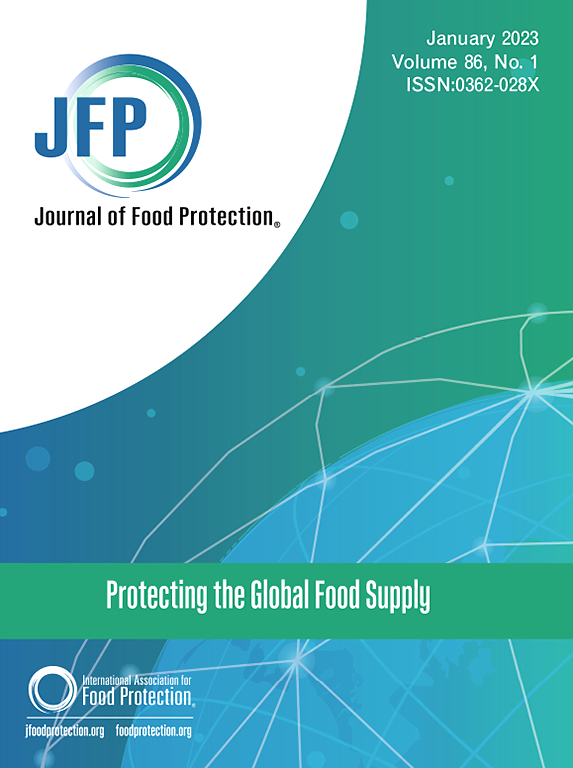Survival of Salmonella on Biodegradable Mulch, Landscape Fabric, and Plastic Mulch
IF 2.1
4区 农林科学
Q3 BIOTECHNOLOGY & APPLIED MICROBIOLOGY
引用次数: 0
Abstract
Ground covers are used in produce production to enhance plant growth and control diseases and pests. While various factors are considered when selecting commercial ground covers, food safety, particularly the survival of foodborne pathogens, is often overlooked. This study aimed to assess the survival of Salmonella on different ground covers, including biodegradable mulch, landscape fabric, and plastic mulch. New rolls of each ground cover were cut to fit a 100 × 15 mm petri dish and spot inoculated with a seven-strain Salmonella cocktail at approximately 6 log CFU/cm2. The inoculated coupons were stored in a climate-controlled chamber (23°C, 55% relative humidity) and sampled at 0, 0.06 (1.5 h), 0.17 (4 h), 1, 2, 3, 5, 7, 30, 60, 90, and 140 days postinoculation (dpi). If counts dropped below the detection limit (<0.12 log CFU/cm2), enrichments were performed following the Food and Drug Administration’s Bacteriological Analytical Manual Salmonella protocol. Salmonella survived 140 dpi on all tested ground covers, with reductions >5 log CFU/cm2. Survival rates at 140 dpi were highest on landscape fabric (83%, 25/30) followed by plastic mulch (50%, 15/30) and biodegradable mulch (13%, 4/30) coupons (p < 0.05). During the first 30 dpi, biodegradable mulch exhibited the smallest reduction in Salmonella (2.47 ± 0.26 log CFU/cm2), compared to landscape fabric (3.07 ± 0.30 log CFU/cm2) and plastic mulch (3.86 ± 0.72 log CFU/cm2). After 60 dpi, Salmonella reductions stabilized across all materials (∼4 log CFU/cm2) and by 90 dpi, no significant differences were observed between ground cover types (p > 0.05). Although Salmonella survival varied among ground covers in the short-term (0–30 dpi), a >5 log CFU/cm2 reduction of Salmonella was observed among all materials by 140 dpi. Findings suggest that ground cover material influences Salmonella survival and should be factored into food safety risk management strategies, especially when ground covers are reused.
沙门氏菌在可生物降解地膜、景观织物和塑料地膜上的存活率。
地被物在生产中用于促进植物生长和控制病虫害。虽然在选择商业地被物时要考虑各种因素,但食品安全,特别是食源性病原体的生存往往被忽视。本研究旨在评估沙门氏菌在不同地被覆盖物上的生存情况,包括可生物降解地膜、景观织物和塑料地膜。每个地被植物的新卷被切割成适合100 x 15 mm的培养皿,并以大约6 log CFU/cm2的速度用7株鸡尾酒沙门氏菌进行现场接种。接种后的样品保存在恒温箱(23℃,55%相对湿度)中,分别于接种后0、0.06 (1.5 h)、0.17 (4 h)、1、2、3、5、7、30、60、90和140天(dpi)取样。如果计数低于检测极限(2),则按照食品和药物管理局的细菌学分析手册沙门氏菌协议进行富集。沙门氏菌在所有测试的地被物上存活140 dpi,减少50 log CFU/cm2。140 dpi存活率最高的是景观布(83%,25/30),其次是地膜(50%,15/30)和可生物降解地膜(13%,4/30),景观布(3.07±0.30 log CFU/cm2)和地膜(3.86±0.72 log CFU/cm2)。在60 dpi后,所有材料的沙门氏菌减少量稳定下来(约4 log CFU/cm2),到90 dpi时,地表覆盖类型之间没有观察到显著差异(p>0.05)。虽然沙门氏菌在短期内(0-30 dpi)的存活率在不同的地被物中有所不同,但在所有材料中观察到沙门氏菌在140 dpi时减少了50 log CFU/cm2。研究结果表明,地被物会影响沙门氏菌的存活,应纳入食品安全风险管理策略,特别是当地被物被重复使用时。
本文章由计算机程序翻译,如有差异,请以英文原文为准。
求助全文
约1分钟内获得全文
求助全文
来源期刊

Journal of food protection
工程技术-生物工程与应用微生物
CiteScore
4.20
自引率
5.00%
发文量
296
审稿时长
2.5 months
期刊介绍:
The Journal of Food Protection® (JFP) is an international, monthly scientific journal in the English language published by the International Association for Food Protection (IAFP). JFP publishes research and review articles on all aspects of food protection and safety. Major emphases of JFP are placed on studies dealing with:
Tracking, detecting (including traditional, molecular, and real-time), inactivating, and controlling food-related hazards, including microorganisms (including antibiotic resistance), microbial (mycotoxins, seafood toxins) and non-microbial toxins (heavy metals, pesticides, veterinary drug residues, migrants from food packaging, and processing contaminants), allergens and pests (insects, rodents) in human food, pet food and animal feed throughout the food chain;
Microbiological food quality and traditional/novel methods to assay microbiological food quality;
Prevention of food-related hazards and food spoilage through food preservatives and thermal/non-thermal processes, including process validation;
Food fermentations and food-related probiotics;
Safe food handling practices during pre-harvest, harvest, post-harvest, distribution and consumption, including food safety education for retailers, foodservice, and consumers;
Risk assessments for food-related hazards;
Economic impact of food-related hazards, foodborne illness, food loss, food spoilage, and adulterated foods;
Food fraud, food authentication, food defense, and foodborne disease outbreak investigations.
 求助内容:
求助内容: 应助结果提醒方式:
应助结果提醒方式:


